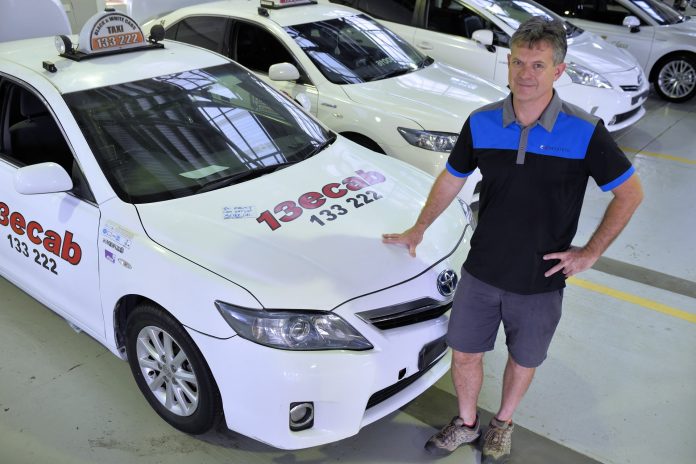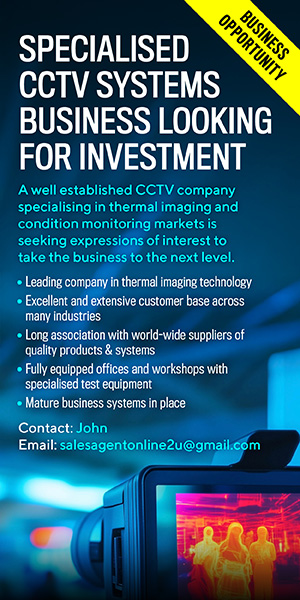Taxicomms has installed its customised Hikvision mobile CCTV solution TaxicamHD for 850 Brisbane-based Black & White Cabs as part of a national roll-out across 2300 P2P Transport taxis. The system comprises internal and external cameras and rugged DVRs, with footage of events accessed by Qld TMR-approved downloaders for Queensland Police.
Taxicomms’ installation of around 850 mobile CCTV systems for Black & White Cabs in Queensland is part of a larger national roll-out of mobile CCTV driven by regular enhancements to state government standards. It goes without saying that safety measures mandated at the state government level have a cadence of their own and this feeds into our story.
Taxicomms is a subsidiary of P2P Transport (P2P) which also owns Black & White Cabs. The P2P Transport fleet of approximately 2300 taxis includes 1100 in Queensland, 400 in NSW, 700 in Victoria and 200 in Western Australia. Founded in Queensland and managed by Greg Witney, Taxicomms has expanded to cover 4 states, with the camera operations side of the business handled by project manager, Guy Bridson.
According to Bridson, branching out as a national supplier is a big step and Taxicomms made this a success by leveraging off the P2P Transport footprint and the experience of its team. Greg Witney has 40 years’ experience in the telecommunications sector with 30 years in the taxi industry, while Bridson has 30 years’ experience in the telecommunications sector and 10 years in the taxi industry.
Wrapping your head around the nature of Australia’s taxi camera programme is part of understanding this application. In the past, Aussie taxis used the VerifEye system, which originated in Dunedin, New Zealand and was taken global by Canadian company VerifEye Technologies Inc. VerifEye was acquired by USA company Lytx in 2016, which closed down the Australian Taxicam programme and subsequently left a huge gap in the market.
“In 2017, QLD, NSW, VIC and WA all changed their taxi security camera system specifications and required upgrades to CCTV systems in thousands of cabs,” explains Bridson. “Regulators have mostly maintained strict controls over the taxi security camera capability, citing occupant privacy, chain of evidence protection and workplace surveillance as key reasons for this control.”

To meet and exceed the technical requirements, Taxicomms developed a solution based on a customised Hikvision DS5504 4-input MDVR platform supplied by Ness Corp. Witney tasked Bridson; who had worked for many years at VerifEye, to manage the process of gaining approval from various state governments. Taxicomms was first to be approved under these new specifications in March 2018 in Western Australia, in April 2018 in Queensland – around 18 months ahead of the opposition – and was approved for the Victoria specification in December 2018. NSW, meanwhile, has started a deregulation of its taxis and does not enforce a CCTV specification.
“The approval process for taxi cameras in most states is rigorous and involves third party engineering ratification, image quality and EMC testing. As the SME for taxi cameras, I quickly set out to obtain approval in QLD and WA, simultaneously achieving this in 4 months and 3 other states within 12 months,” Bridson explains. “Other suppliers have taken 12–18 months to achieve similar results.
“Getting such fast approval put Taxicomms at a significant advantage commercially, particularly in Queensland, where we enjoyed sole supplier status for around 12 months. We could not have achieved this extremely fast path to approval without the support of Hikvision and Ness Corp. Many of the requests are unique and difficult to obtain but Hikvision engineering was helpful and quick to respond, its technical capabilities are superior, and documentation was of a high quality.”
The TaxicamHD Solution
Selecting the right solution to replace the legacy VerifEye system was a process driven in part by the flagging performance of the legacy systems. The 2005 solution used in Queensland was only running at 1 frame every 10 seconds, stepping up to 1 frame per second when triggered, and it only had 32 hours of storage. While the low light performance of the VerifEye cameras was excellent – resolution was S-VHS quality – the new systems are capable of 720p, which is a big improvement.
“By 2017, Witney found supporting the legacy cameras was becoming more difficult, so he set out to find a suitable new camera partner,” explains Bridson. “He chose Hikvision/Ness due the superiority of the DS5504 MDVR 4-input platform, its 3-year warranty (mandatory for Queensland taxi camera specification), and the superior technical support on offer. This has proven a good choice – Hikvision and Ness are very responsive and agile.”

According to Bridson, an exclusive channel partnership agreement was entered into between Hikvision, Ness and Taxicomms in mid-2018.
“When it comes to our system, we’ve taken a generic Hikvision product and we’ve customised it to meet the specification,” Bridson explains. “We came to an agreement on hardware and firmware and I dealt with Hikvision’s engineering teams in Sydney and in China. Dylan Dong is our Hikvision chief engineer on this project and we recently went to China to give the engineering team there some feedback and discuss a few customisation points.
“It’s an impressive operation. We met with the programme managers and visited the factory. It was useful to sit down with the programme managers to understand the picture from both sides. We are a difficult customer for Hikvision because we are comparatively small. We’ve sold 2000 systems in the past 12 months, which is a big deal for us but nothing for Hikvision, which manufactures 3 million CCTV cameras a year. At the moment we are working on customisation of their IVMS and API, which allows us to get software developed ourselves and then add it to their system.”

Along the way, Taxicomms realised they had built their considerable experience and expertise into the product.
“A decision to rebrand the DS-5504 MDVR to TaxicamHD was taken to protect the partnership and prevent parallel importing, which is a developing problem for suppliers of lower quality systems,” Bridson says.
On the technical side, image quality and storage are the key qualities.
“In-car storage is SSD and we have insisted on industrial grade because it lasts and has wear levelling technology in it,” explains Bridson. “The standard taxi is running a 256GB system – in comparison the old system had a 2GB CF card, which in 2007 used to cost about $200 – we get these 256GB SSDs for that now days. We think SD cards are not appropriate in this application. If you think 6 frames per second per camera minimum of 2 cameras in a vehicle (12 frames per second) 60 seconds x 60 minutes x 24 hours x 365 equals 100s of millions of write image cycles per year and you want at least 6 years from a storage solution. The only technology that can deliver this is industrial grade solid state.
“System power is tapped off the vehicle – our techs are trained to pick up a constant power supply and accessories line so that the device is on for the duration of the vehicle ignition being on and for 30 minutes after the vehicle is turned off. The DVR power supply manages power fluctuations very well. The old specification had a fireproof, waterproof memory because the risk profile accessed by the governments at the time (circa 2005 – 2010). It was thought that there was major risk of vehicles being burnt after serious crimes but in reality over 10 years there were only a dozen or so fires across the entire taxi fleet which did not justify the additional cost of a fireproof memory module – a percentage of the systems did not survive fires anyway.”

A key issue with any mobile CCTV system is accessing the footage in the event of a crime.
“In terms of accessing the footage we still have to plug a laptop into the system post incident,” Bridson says. “The system is capable of automatically downloading but cost and logistics are an issue. The end user is the police – they are ones that look at the footage – the taxi operators pay for the equipment, but they are not allowed to look at footage.
“We are adding road-facing cameras and allowing operators to have access to those using a different profile – this adds some value for them. Taxi companies have wanted that for a long time, but it was prohibited under the previous specification here in Queensland. Taxis have a CTP risk profile that is 12x higher for accidents than passenger vehicles although this is lower than it was a few years ago(18x).
“We think if we could add driver management incentives through this system, we could reduce further and provide proof to insurers through collected data statistics that we could achieve a significant reduction in CTP insurance costs. These taxis are doing 200,000km-plus each year.”
There are 2 TaxicamHD solutions, the sedan and the maxi. In the sedan version there’s an external camera and an internal camera. There’s a status indicator so the driver knows the camera is on – it’s illegal for a driver to start a shift with a faulty CCTV system. The internal camera sits up near the rear-view mirror.
In a maxi cab there could be 3 cameras depending on the seating configuration. There will be one on the right and left-hand side externally to cover anyone or anything approaching from the side and one looking backwards into the cab. Drivers might fall asleep at a taxi rank waiting for a fare and people reach through windows to snatch things.

According to Bridson, most crime that happens in a maxi, happens around the sliding door or at the driver’s side window.
“There is a duress button integrated into the telematics system – that includes audio recording of what is being said in the vehicle – certainly an advantage of having the ability to access the cameras remotely in real time would being able to livestream into the vehicle to check if a duress event is real,” he says. “Around 80 per cent of triggered duress events are false alarms – the operators managing the telematics systems would be the ones that see the footage – including violent footage. That raises additional issues around training staff responding to violent crime in real time.”
Bridson says there’s no video analytics applied to the system at this time. Taxi CCTV solutions are quite basic and the only improvements over the years have been hardware-based – higher resolution and increases in frame rate and storage capacity. According to Bridson, this comes back to the regulator and to tension on costs. He says that around $A2000 is the ceiling and if costs go higher there is push back from the market.

“The DVR is in the boot of the car and is fitted with a tamper proof housing – it’s all bolted in and would need to be crow barred out – that’s the anti-vandalism capability,” Bridson explains. “The unit is low profile so it takes up minimal room and can be tucked away.
“TaxicamHD is capable of 1080p at 30 frames a second but no taxi operator is going to pay for a 2TB SSD – the maximum resolution we run is 1280 x 720 pixels at present. There’s that triangle of resolution, frame rate and rollover time – these are the factors that balance performance and cost. Compression is another important part of this equation. Surprisingly, there has been a pretty good uptake on road-facing dashcam solutions. We probably underestimated the pickup on that. For instance, Suncoast Cabs has rolled it out throughout their fleet and in other fleets, individuals are taking it up.”
Challenges of the Application
As you’d imagine, mobile CCTV systems face challenges given the tough conditions they work in – the environment is hot, there’s vibration and depending on location, there may be knocks from luggage. This means systems must be well designed, well installed and properly maintained.
“It’s not only heat, vibration and rainfall – the external cameras have to deal with being water-blasted during daily cleaning – the Hikvision cameras are really standing up to it well,” Bridson says. “It might be 50C in the boot, while the dashboard of a car can reach >60C on a 35C day in summer – that’s very challenging for any electrical equipment.
“These Hikvision cameras just last – by comparison I’ve seen some of our competitors’ cameras melting off the windscreens of their cabs. There’s stress on the storage units, too. Typically, SSDs will stop working at around 85C – this can happen in a boot if the DVR is covered with a coat and heat is not dissipating. In our experience, the TaxicamHD system is the most reliable add-on system in the car.”

But according to Bridson, the greatest challenges of the application with Black & White Cabs and other fleets nationally weren’t technical.
“Involvement in taxi camera programmes is niche and difficult because the markets are small,” he explains. “Regulators like to control specifications, the sale is a grudge purchase as the purchasers are not usually the end benefactor of the footage (police and courts are) and deadlines for taxis to roll over to new cameras continue to be changed as the industry pushes back politically in a tough economic environment battling de-regulation and the introduction of ridesharing.
“For example, QTMR has pushed its roll-out deadline back 3 times since April 2018, while Victoria and NSW finally set a February/March 2021 deadline, and Western Australia has set July 2020. This poses big problems for suppliers who must either plan for or simply cop the probability of having to carry more stock on hand than they may be comfortable doing under normal commercial conditions.

“As TaxicamHD has unique customisations to meet the specs, it would be difficult for either Hikvision or Ness to offload surpluses to other markets and so a certain amount of trust, along with a very agile supply chain, has been key to ensuring Taxicomms has the necessary freedom of manoeuvre required, for which we are very grateful. Having sales campaigns running across multiple states simultaneously has helped the partnership by clearing any backlogs of stock as a result of sales slow-downs and date changes.
“Another challenge for us is the lack of security for rideshare and the seeming lack of policing of this, which ultimately affects public safety. It would be good to see cameras fitted to ride share vehicles too. I think a lighter version of the taxi camera would be appropriate here – a secure dashcam solution on a rental model would be a great sales opportunity in the future.”
Performance and Management
After we’ve poked around a cab and a maxi, taking a look at the system installations currently being undertaken at the Taxicomms workshop, we head into the office and Bridson calls up video footage on a workstation. We look at day and night performance – night performance is monochrome supported by IR.
“That’s daylight performance in a maxi taxi, Bridson explains, opening files, “And here’s night and twilight. You can see the night shot is actually better than the daytime shot – that’s an example of how seriously we take security – crime rates are highest between 11pm and 3am and we have got to have a camera with credible performance during that time period. That’s what we and Hikvision are focused on.”

Looking at the monitor I can see useful range is about 4 metres and there’s a good projection of IR light through the vehicle. According to Bridson, taxi camera systems don’t need a lot of range.
“The specification asks for 3 x 3 metre or 3 x 5 metre coverage. There’s a balance because the greater the angle of view, the more powerful the IR needs to be,” he says. “The camera we use has a hyperfocal distance of 300mm and an operational range of 5 metres, which is perfect for our needs.
“At close ranges IR can flare but these cameras have a dynamic illumination package so as soon as you start coming in, image quality is enhanced, and the IR power is reduced. Cheaper cameras don’t have this technology – when you’re looking at close targets inside 500mm – there’s nothing but flare. Hikvision has 15,000 R&D engineers and the flow on effect of what they are doing across the product range for other markets is what makes this product superior at this price point. When you look at the performance, the value speaks for itself.
“I talk a lot about the iceberg effect with customers – it’s not about the sale, it’s about the support. You must have reliability, availability and maintainability. You don’t get that with a cheap sale.”

As Bridson goes through the images it’s clear camera performance is solid. Getting quality CCTV coverage in a car with a shaded interior and full sunlight outside is not for cameras faint of heart. Something else I notice is that the view from the 2.1mm lens on the internal cameras is plenty wide. The external cameras are 2.8mm, which gives more reach (3-5 metres) and increases pixel density across the angle of view. With IR on at night flare is reasonably well controlled, considering how close everything is to the lens.
Court admissible camera performance is the key to a taxi camera system. According to Bridson, there are 300-400 downloads of footage for criminal acts involving Queensland-based Black & White Cabs taxis annually – it’s 700 statewide, similar statistics for the other major states. Many of these downloads are undertaken as part of investigations into serious offences.
“We have a good relationship with QPS and with the Scenes of Crimes Team,” Bridson says. “I’ve done an expert witness course so I can help them out. You are a witness when you download footage and doing that needs some technical ability so police will bring you in to explain an event to the court – this happened often with the old system because it was trigger augmented and video came out disjointed – it jumped back and forth in time.

“The defence would pick that up straight away and say ‘Look, it’s not working properly, that video is all over the place’. You’d have to explain in a non-technical way what the system was doing so the court could understand what they were seeing. The new system is continuous video so it’s not as complex to view, but there will still be times we’ll have to explain things in court. Because there’s video footage showing the accused, the defence will always attack the system that is delivering the video stream – it’s really their only avenue.
“The procedures we follow are in line with forensic CCTV procedures to make sure we get the chain of evidence that we need. In my career a person has been acquitted of murder on a technicality because there was no forward-facing camera – the evidence did not conclusively prove the crime – that’s how important CCTV is in these applications.”
Conclusion
Although taxi camera systems aren’t complex, they function in a rugged environment and are regularly used by police to investigate serious crimes. This means performance and reliability are vital but because overall system numbers are small, integrators must undertake customisation of hardware developed for other verticals. This adds a layer of complexity from an integrator’s point of view. A key underlying element in this application has been Taxicomms’ ability to engineer its long experience into existing hardware.
As well as the support of Hikvision, Taxicomms has benefited from its partnership with distributor Ness Corp. According to Bridson, Ness adds significant value to the supply chain.
“Just having considerable stock in country has been a massive help,” he says. “When a taxi is not on the road it can’t make money – it’s really tight at the moment for taxis competing with rideshare. The more we can keep those cars on the road the better – that’s what makes supply logistics for our hardware so important. Our competitors have not got their heads around that yet.”

Bridson drives the VMS software.
When it comes to the future of mobile CCTV solutions, Bridson says that’s going to be about expanding use vectors and taking clever systems into the wider transport market.
“The users of these taxi camera systems want them to be compliant and affordable, but they are not being strategic with the technology… yet,” he says. “We believe these systems could save hundreds of lives by managing driver behaviour in real time, reducing accidents and slashing CTP costs across the millions of vehicles in the commercial transport industry. That’s the future of mobile CCTV systems.”
#securityelectronicsandnetworks.com












